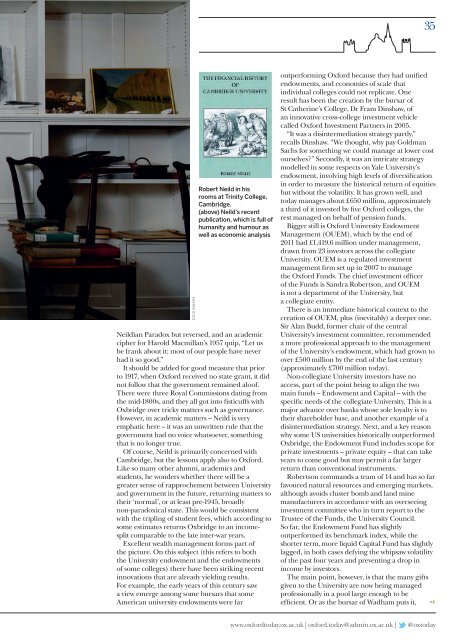Oxford today
Oxford today
Oxford today
Create successful ePaper yourself
Turn your PDF publications into a flip-book with our unique Google optimized e-Paper software.
dick makin<br />
Robert Neild in his<br />
rooms at Trinity College,<br />
Cambridge.<br />
(above) Neild’s recent<br />
publication, which is full of<br />
humanity and humour as<br />
well as economic analysis<br />
Neildian Paradox but reversed, and an academic<br />
cipher for Harold Macmillan’s 1957 quip, “Let us<br />
be frank about it: most of our people have never<br />
had it so good.”<br />
It should be added for good measure that prior<br />
to 1917, when <strong>Oxford</strong> received no state grant, it did<br />
not follow that the government remained aloof.<br />
There were three Royal Commissions dating from<br />
the mid-1800s, and they all got into fisticuffs with<br />
Oxbridge over tricky matters such as governance.<br />
However, in academic matters – Neild is very<br />
emphatic here – it was an unwritten rule that the<br />
government had no voice whatsoever, something<br />
that is no longer true.<br />
Of course, Neild is primarily concerned with<br />
Cambridge, but the lessons apply also to <strong>Oxford</strong>.<br />
Like so many other alumni, academics and<br />
students, he wonders whether there will be a<br />
greater sense of rapprochement between University<br />
and government in the future, returning matters to<br />
their ‘normal’, or at least pre-1945, broadly<br />
non-paradoxical state. This would be consistent<br />
with the tripling of student fees, which according to<br />
some estimates returns Oxbridge to an incomesplit<br />
comparable to the late inter-war years.<br />
Excellent wealth management forms part of<br />
the picture. On this subject (this refers to both<br />
the University endowment and the endowments<br />
of some colleges) there have been striking recent<br />
innovations that are already yielding results.<br />
For example, the early years of this century saw<br />
a view emerge among some bursars that some<br />
American university endowments were far<br />
35<br />
outperforming <strong>Oxford</strong> because they had unified<br />
endowments, and economies of scale that<br />
individual colleges could not replicate. One<br />
result has been the creation by the bursar of<br />
st Catherine’s College, Dr Fram Dinshaw, of<br />
an innovative cross-college investment vehicle<br />
called <strong>Oxford</strong> Investment Partners in 2005.<br />
“It was a disintermediation strategy partly,”<br />
recalls Dinshaw. “We thought, why pay Goldman<br />
sachs for something we could manage at lower cost<br />
ourselves?” secondly, it was an intricate strategy<br />
modelled in some respects on Yale University’s<br />
endowment, involving high levels of diversification<br />
in order to measure the historical return of equities<br />
but without the volatility. It has grown well, and<br />
<strong>today</strong> manages about £650 million, approximately<br />
a third of it invested by five <strong>Oxford</strong> colleges, the<br />
rest managed on behalf of pension funds.<br />
Bigger still is <strong>Oxford</strong> University Endowment<br />
Management (OUEM), which by the end of<br />
2011 had £1,419.6 million under management,<br />
drawn from 23 investors across the collegiate<br />
University. OUEM is a regulated investment<br />
management firm set up in 2007 to manage<br />
the <strong>Oxford</strong> Funds. The chief investment officer<br />
of the Funds is sandra Robertson, and OUEM<br />
is not a department of the University, but<br />
a collegiate entity.<br />
There is an immediate historical context to the<br />
creation of OUEM, plus (inevitably) a deeper one.<br />
sir Alan Budd, former chair of the central<br />
University’s investment committee, recommended<br />
a more professional approach to the management<br />
of the University’s endowment, which had grown to<br />
over £500 million by the end of the last century<br />
(approximately £700 million <strong>today</strong>).<br />
Non-collegiate University investors have no<br />
access, part of the point being to align the two<br />
main funds – Endowment and Capital – with the<br />
specific needs of the collegiate University. This is a<br />
major advance over banks whose sole loyalty is to<br />
their shareholder base, and another example of a<br />
disintermediation strategy. Next, and a key reason<br />
why some Us universities historically outperformed<br />
Oxbridge, the Endowment Fund includes scope for<br />
private investments – private equity – that can take<br />
years to come good but may permit a far larger<br />
return than conventional instruments.<br />
Robertson commands a team of 14 and has so far<br />
favoured natural resources and emerging markets,<br />
although avoids cluster bomb and land mine<br />
manufacturers in accordance with an overseeing<br />
investment committee who in turn report to the<br />
Trustee of the Funds, the University Council.<br />
so far, the Endowment Fund has slightly<br />
outperformed its benchmark index, while the<br />
shorter term, more liquid Capital Fund has slightly<br />
lagged, in both cases defying the whipsaw volatility<br />
of the past four years and preventing a drop in<br />
income by investors.<br />
The main point, however, is that the many gifts<br />
given to the University are now being managed<br />
professionally in a pool large enough to be<br />
efficient. Or as the bursar of Wadham puts it, ➺<br />
www.oxford<strong>today</strong>.ox.ac.uk | oxford.<strong>today</strong>@admin.ox.ac.uk | @ox<strong>today</strong>


